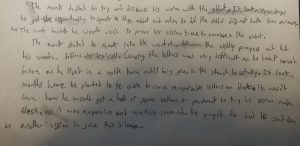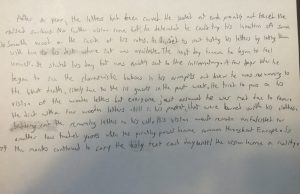Below is a hand-written text entitled “A Monk’s Dream Unfulfilled.” It is a story of a young monk who receives a vision about the printing press and starts to think about how he can fulfill this vision from God. Inspired by this week’s assigned podcasts from Stuff To Blow Your Mind and the video on the Medieval Help desk.



I normally write by typing at a laptop computer. I very rarely produce text for others by hand, however I will write by hand when making notes for myself. Mobility and efficiency are typically my greatest considerations when deciding to write by hand or by type. I have always disliked doing homework at a desk and using a laptop allows for more options like writing with the laptop on my chest outside or on a bed. Mobility is also the reason I choose to write by hand during inspections- I find it easier and lighter to move a clipboard and pen around then a laptop in a busy, cramped kitchen. Efficiency is the other consideration. If I can enter something directly in a program in real time I try to do that as it is more efficient than doing it first by hand and then again by type. When doing inspections, the mobility overrides the efficiency but if we had lighter tablets instead of laptops then that consideration may shift in favour of efficiency.
I found this task difficult for a number of reasons. The biggest was the need to write linearly. The greatest advantage of typing on a computer is the ability to move text around easily. When writing an essay, I like to free write, then organize paragraphs, while doing introductions and conclusions last or when I am stuck in the middle of the assignment. I chose to write a story in the hopes it would help me to write more linearly however it was still difficult. Many teachers and professors realize this recursive nature of writing such as Stetson University (n.d.) yet few articles talk about the affordances of computer typing for recursive, non-linear writing. I chose to write in pencil so I could erase my work but the eraser marks are very noticeable. I would imagine it was the same when the scribe would scrape a mistake from the vellum media. I found I had to ignore my desire to change my writing as I would have needed to start on a new page and redo previous work (that desire for efficiency was riding me). Sometimes I would also just write over the letter, this was typically when I misformed part of the letter (particularly an issue with u, b and d today). If I had chosen to work in pen I would have needed to scribble out mistakes instead which would have effected my average words per line and broken up the story flow. Spelling is also difficult for me and I found myself using the computer for some words or switching my word choice to something I could spell without help. Likely spelling mistakes remain in the text. It made me really appreciate the easy of editing in a computer typed document (a typewriter is similar to writing by hand due to the difficultly in editing).
The inability to edit without redoing work or making the text look unclean was one of the most significant differences between writing by hand and using a computer. I vastly prefer a computer for this reason as it allows me to produce professional looking texts more easily and allows for quick edits throughout the text. Starting over on a new sheet of paper to recopy existing work hurts my efficient soul. However if we are thinking about writing by hand compared to the typewriter speed or uniformity of the text would be the most significant difference while writing by hand and the printing press would have speed and uniformity between copies be its greatest difference. Thus mechanized writing as a whole cannot be easily compared to writing by hand as there are many forms of mechanized writing.
References
Stetson University. (n.d.). Writing Program. Retrieved June 12, 2022, from https://www.stetson.edu/other/writing-center/media/G_Part_3.pdf
Resources for Story:
Cleveland Clinic. (2021, June 17). Bubonic plague (black death): What is it, symptoms, treatment. Cleveland Clinic. Retrieved June 12, 2022, from https://my.clevelandclinic.org/health/diseases/21590-bubonic-plague
Mepkin Abbey. (2021, February 12). Liturgy of the hours. Mepkin Abbey. Retrieved June 12, 2022, from https://mepkinabbey.org/liturgyofthehours/
Lamb, R. & McCormick, J. (Hosts). (2021, May 8). From the vault: Invention of the book, part 1 [Audio podcast episode]. In Stuff to blow your mind. https://www.iheart.com/podcast/stuff-to-blow-your-mind-21123915/episode/from-the-vault-invention-of-the-82316952/
Lamb, R. & McCormick, J. (Hosts). (2021, May 15). From the vault: Invention of the book, part 2 [Audio podcast episode]. In Stuff to blow your mind. https://www.iheart.com/podcast/stuff-to-blow-your-mind-21123915/episode/from-the-vault-invention-of-the-82564254/


